LEADERSHIP MANAGEMENT IN AUSTRALIAN SCHOOL SETTING
VerifiedAdded on 2022/08/18
|13
|3279
|14
AI Summary
Contribute Materials
Your contribution can guide someone’s learning journey. Share your
documents today.
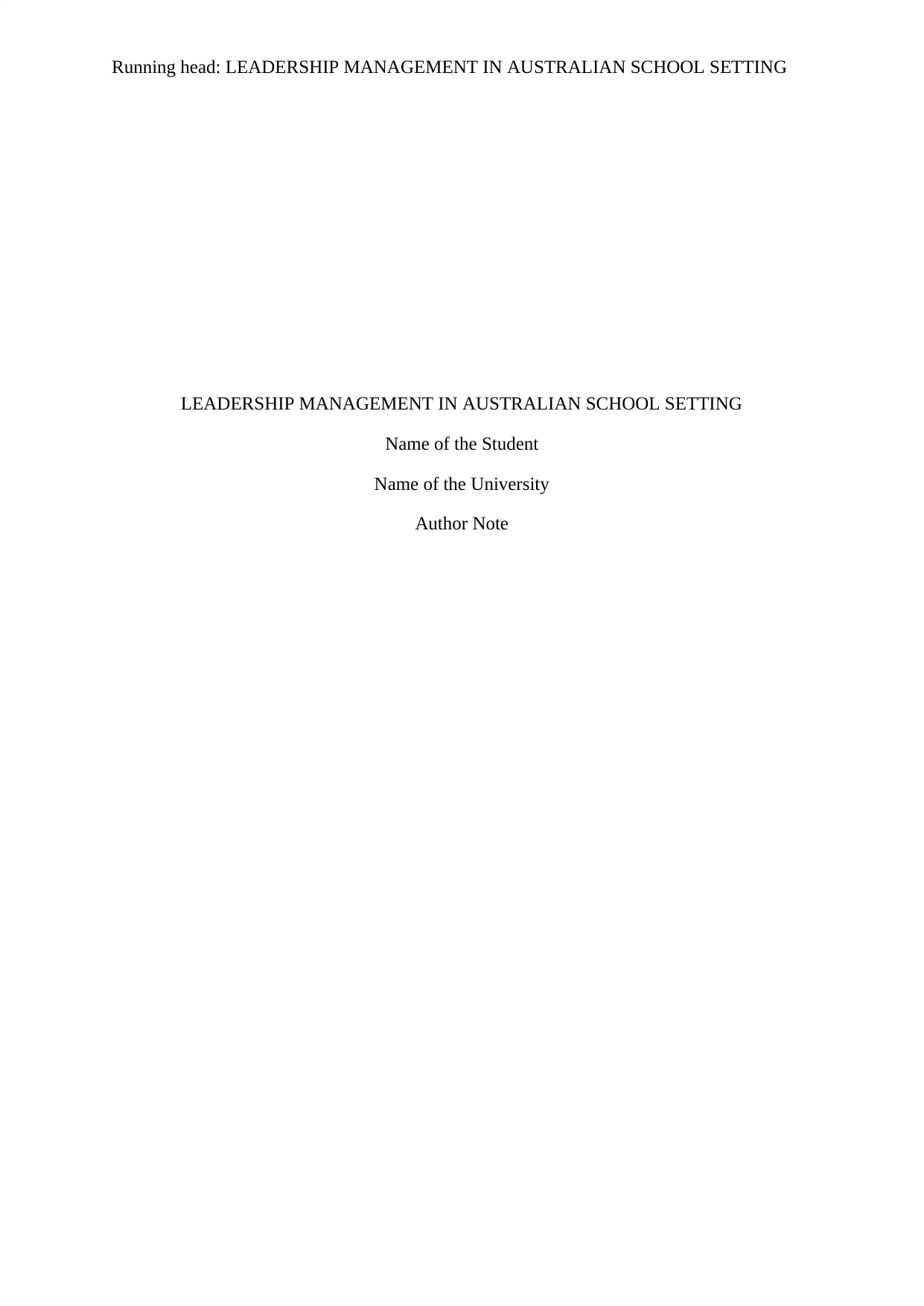
Running head: LEADERSHIP MANAGEMENT IN AUSTRALIAN SCHOOL SETTING
LEADERSHIP MANAGEMENT IN AUSTRALIAN SCHOOL SETTING
Name of the Student
Name of the University
Author Note
LEADERSHIP MANAGEMENT IN AUSTRALIAN SCHOOL SETTING
Name of the Student
Name of the University
Author Note
Secure Best Marks with AI Grader
Need help grading? Try our AI Grader for instant feedback on your assignments.
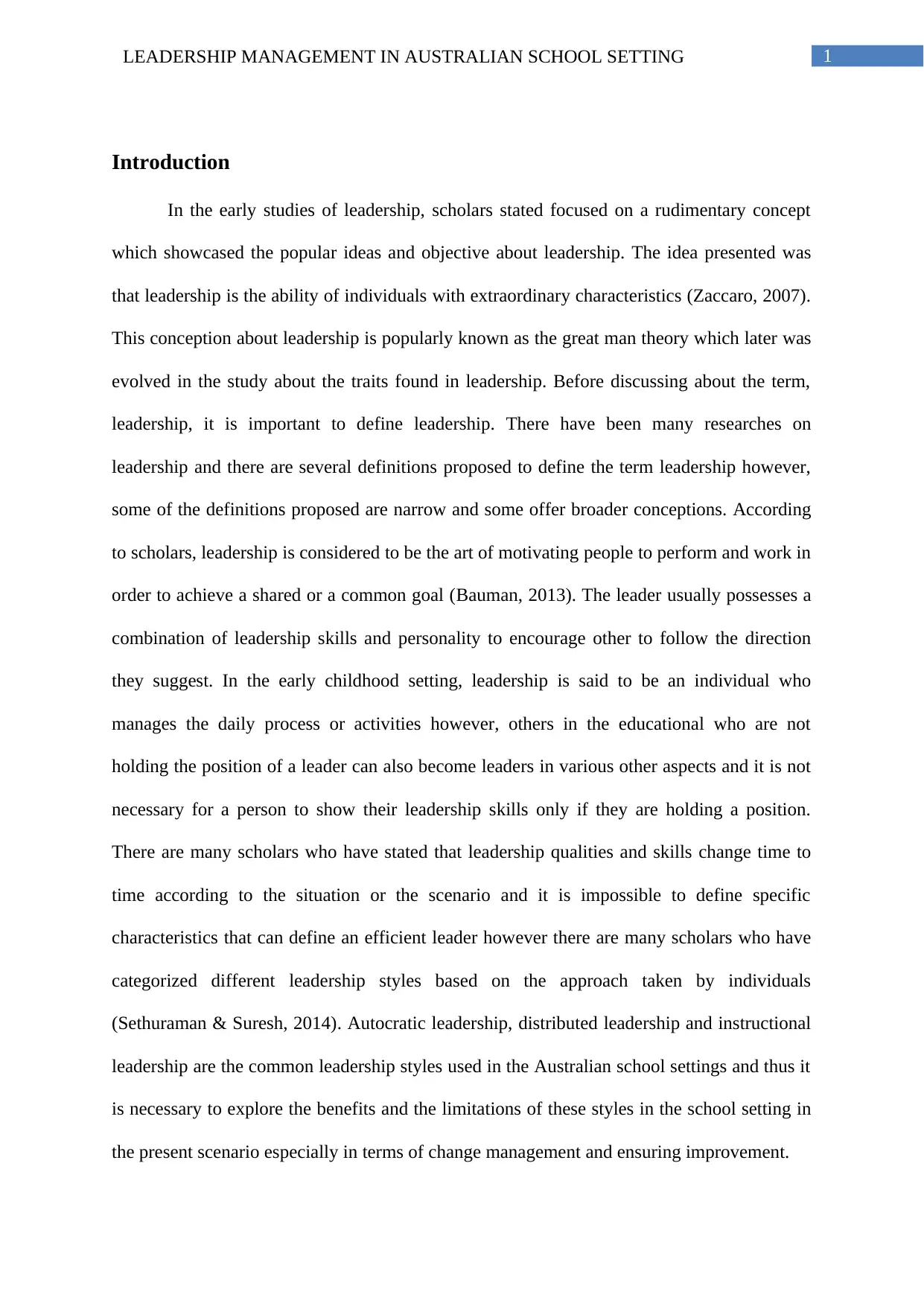
1LEADERSHIP MANAGEMENT IN AUSTRALIAN SCHOOL SETTING
Introduction
In the early studies of leadership, scholars stated focused on a rudimentary concept
which showcased the popular ideas and objective about leadership. The idea presented was
that leadership is the ability of individuals with extraordinary characteristics (Zaccaro, 2007).
This conception about leadership is popularly known as the great man theory which later was
evolved in the study about the traits found in leadership. Before discussing about the term,
leadership, it is important to define leadership. There have been many researches on
leadership and there are several definitions proposed to define the term leadership however,
some of the definitions proposed are narrow and some offer broader conceptions. According
to scholars, leadership is considered to be the art of motivating people to perform and work in
order to achieve a shared or a common goal (Bauman, 2013). The leader usually possesses a
combination of leadership skills and personality to encourage other to follow the direction
they suggest. In the early childhood setting, leadership is said to be an individual who
manages the daily process or activities however, others in the educational who are not
holding the position of a leader can also become leaders in various other aspects and it is not
necessary for a person to show their leadership skills only if they are holding a position.
There are many scholars who have stated that leadership qualities and skills change time to
time according to the situation or the scenario and it is impossible to define specific
characteristics that can define an efficient leader however there are many scholars who have
categorized different leadership styles based on the approach taken by individuals
(Sethuraman & Suresh, 2014). Autocratic leadership, distributed leadership and instructional
leadership are the common leadership styles used in the Australian school settings and thus it
is necessary to explore the benefits and the limitations of these styles in the school setting in
the present scenario especially in terms of change management and ensuring improvement.
Introduction
In the early studies of leadership, scholars stated focused on a rudimentary concept
which showcased the popular ideas and objective about leadership. The idea presented was
that leadership is the ability of individuals with extraordinary characteristics (Zaccaro, 2007).
This conception about leadership is popularly known as the great man theory which later was
evolved in the study about the traits found in leadership. Before discussing about the term,
leadership, it is important to define leadership. There have been many researches on
leadership and there are several definitions proposed to define the term leadership however,
some of the definitions proposed are narrow and some offer broader conceptions. According
to scholars, leadership is considered to be the art of motivating people to perform and work in
order to achieve a shared or a common goal (Bauman, 2013). The leader usually possesses a
combination of leadership skills and personality to encourage other to follow the direction
they suggest. In the early childhood setting, leadership is said to be an individual who
manages the daily process or activities however, others in the educational who are not
holding the position of a leader can also become leaders in various other aspects and it is not
necessary for a person to show their leadership skills only if they are holding a position.
There are many scholars who have stated that leadership qualities and skills change time to
time according to the situation or the scenario and it is impossible to define specific
characteristics that can define an efficient leader however there are many scholars who have
categorized different leadership styles based on the approach taken by individuals
(Sethuraman & Suresh, 2014). Autocratic leadership, distributed leadership and instructional
leadership are the common leadership styles used in the Australian school settings and thus it
is necessary to explore the benefits and the limitations of these styles in the school setting in
the present scenario especially in terms of change management and ensuring improvement.
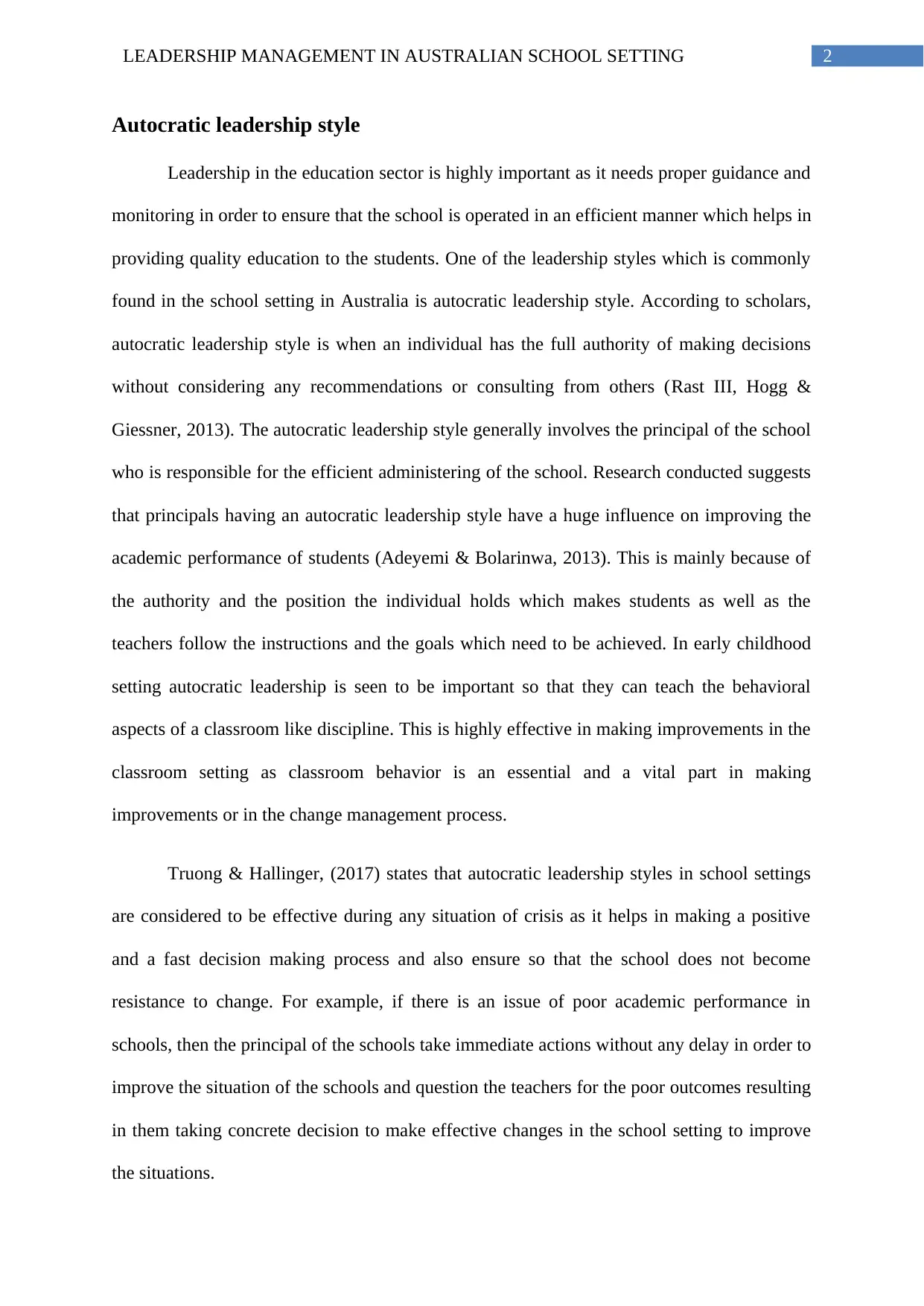
2LEADERSHIP MANAGEMENT IN AUSTRALIAN SCHOOL SETTING
Autocratic leadership style
Leadership in the education sector is highly important as it needs proper guidance and
monitoring in order to ensure that the school is operated in an efficient manner which helps in
providing quality education to the students. One of the leadership styles which is commonly
found in the school setting in Australia is autocratic leadership style. According to scholars,
autocratic leadership style is when an individual has the full authority of making decisions
without considering any recommendations or consulting from others (Rast III, Hogg &
Giessner, 2013). The autocratic leadership style generally involves the principal of the school
who is responsible for the efficient administering of the school. Research conducted suggests
that principals having an autocratic leadership style have a huge influence on improving the
academic performance of students (Adeyemi & Bolarinwa, 2013). This is mainly because of
the authority and the position the individual holds which makes students as well as the
teachers follow the instructions and the goals which need to be achieved. In early childhood
setting autocratic leadership is seen to be important so that they can teach the behavioral
aspects of a classroom like discipline. This is highly effective in making improvements in the
classroom setting as classroom behavior is an essential and a vital part in making
improvements or in the change management process.
Truong & Hallinger, (2017) states that autocratic leadership styles in school settings
are considered to be effective during any situation of crisis as it helps in making a positive
and a fast decision making process and also ensure so that the school does not become
resistance to change. For example, if there is an issue of poor academic performance in
schools, then the principal of the schools take immediate actions without any delay in order to
improve the situation of the schools and question the teachers for the poor outcomes resulting
in them taking concrete decision to make effective changes in the school setting to improve
the situations.
Autocratic leadership style
Leadership in the education sector is highly important as it needs proper guidance and
monitoring in order to ensure that the school is operated in an efficient manner which helps in
providing quality education to the students. One of the leadership styles which is commonly
found in the school setting in Australia is autocratic leadership style. According to scholars,
autocratic leadership style is when an individual has the full authority of making decisions
without considering any recommendations or consulting from others (Rast III, Hogg &
Giessner, 2013). The autocratic leadership style generally involves the principal of the school
who is responsible for the efficient administering of the school. Research conducted suggests
that principals having an autocratic leadership style have a huge influence on improving the
academic performance of students (Adeyemi & Bolarinwa, 2013). This is mainly because of
the authority and the position the individual holds which makes students as well as the
teachers follow the instructions and the goals which need to be achieved. In early childhood
setting autocratic leadership is seen to be important so that they can teach the behavioral
aspects of a classroom like discipline. This is highly effective in making improvements in the
classroom setting as classroom behavior is an essential and a vital part in making
improvements or in the change management process.
Truong & Hallinger, (2017) states that autocratic leadership styles in school settings
are considered to be effective during any situation of crisis as it helps in making a positive
and a fast decision making process and also ensure so that the school does not become
resistance to change. For example, if there is an issue of poor academic performance in
schools, then the principal of the schools take immediate actions without any delay in order to
improve the situation of the schools and question the teachers for the poor outcomes resulting
in them taking concrete decision to make effective changes in the school setting to improve
the situations.
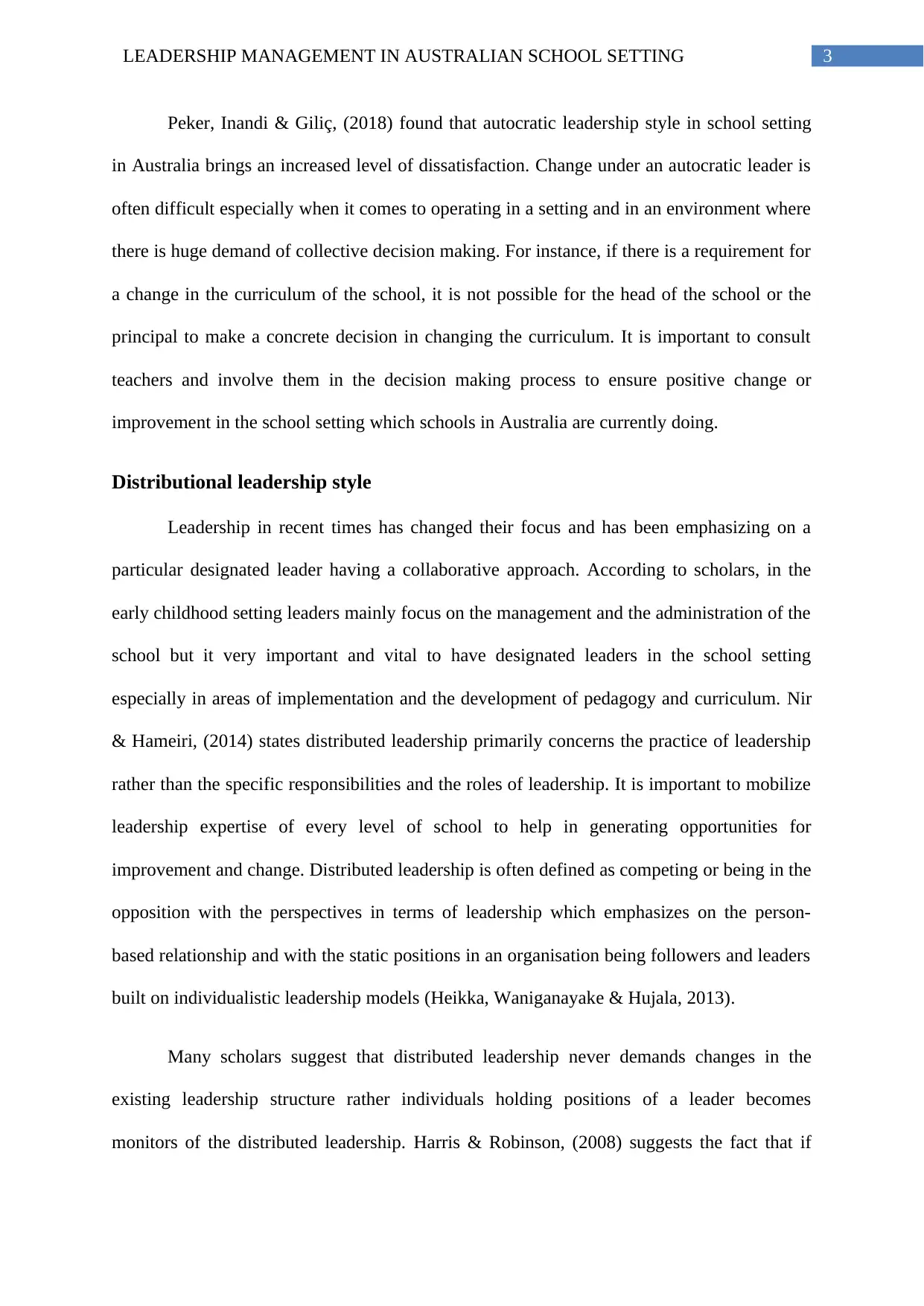
3LEADERSHIP MANAGEMENT IN AUSTRALIAN SCHOOL SETTING
Peker, Inandi & Giliç, (2018) found that autocratic leadership style in school setting
in Australia brings an increased level of dissatisfaction. Change under an autocratic leader is
often difficult especially when it comes to operating in a setting and in an environment where
there is huge demand of collective decision making. For instance, if there is a requirement for
a change in the curriculum of the school, it is not possible for the head of the school or the
principal to make a concrete decision in changing the curriculum. It is important to consult
teachers and involve them in the decision making process to ensure positive change or
improvement in the school setting which schools in Australia are currently doing.
Distributional leadership style
Leadership in recent times has changed their focus and has been emphasizing on a
particular designated leader having a collaborative approach. According to scholars, in the
early childhood setting leaders mainly focus on the management and the administration of the
school but it very important and vital to have designated leaders in the school setting
especially in areas of implementation and the development of pedagogy and curriculum. Nir
& Hameiri, (2014) states distributed leadership primarily concerns the practice of leadership
rather than the specific responsibilities and the roles of leadership. It is important to mobilize
leadership expertise of every level of school to help in generating opportunities for
improvement and change. Distributed leadership is often defined as competing or being in the
opposition with the perspectives in terms of leadership which emphasizes on the person-
based relationship and with the static positions in an organisation being followers and leaders
built on individualistic leadership models (Heikka, Waniganayake & Hujala, 2013).
Many scholars suggest that distributed leadership never demands changes in the
existing leadership structure rather individuals holding positions of a leader becomes
monitors of the distributed leadership. Harris & Robinson, (2008) suggests the fact that if
Peker, Inandi & Giliç, (2018) found that autocratic leadership style in school setting
in Australia brings an increased level of dissatisfaction. Change under an autocratic leader is
often difficult especially when it comes to operating in a setting and in an environment where
there is huge demand of collective decision making. For instance, if there is a requirement for
a change in the curriculum of the school, it is not possible for the head of the school or the
principal to make a concrete decision in changing the curriculum. It is important to consult
teachers and involve them in the decision making process to ensure positive change or
improvement in the school setting which schools in Australia are currently doing.
Distributional leadership style
Leadership in recent times has changed their focus and has been emphasizing on a
particular designated leader having a collaborative approach. According to scholars, in the
early childhood setting leaders mainly focus on the management and the administration of the
school but it very important and vital to have designated leaders in the school setting
especially in areas of implementation and the development of pedagogy and curriculum. Nir
& Hameiri, (2014) states distributed leadership primarily concerns the practice of leadership
rather than the specific responsibilities and the roles of leadership. It is important to mobilize
leadership expertise of every level of school to help in generating opportunities for
improvement and change. Distributed leadership is often defined as competing or being in the
opposition with the perspectives in terms of leadership which emphasizes on the person-
based relationship and with the static positions in an organisation being followers and leaders
built on individualistic leadership models (Heikka, Waniganayake & Hujala, 2013).
Many scholars suggest that distributed leadership never demands changes in the
existing leadership structure rather individuals holding positions of a leader becomes
monitors of the distributed leadership. Harris & Robinson, (2008) suggests the fact that if
Secure Best Marks with AI Grader
Need help grading? Try our AI Grader for instant feedback on your assignments.
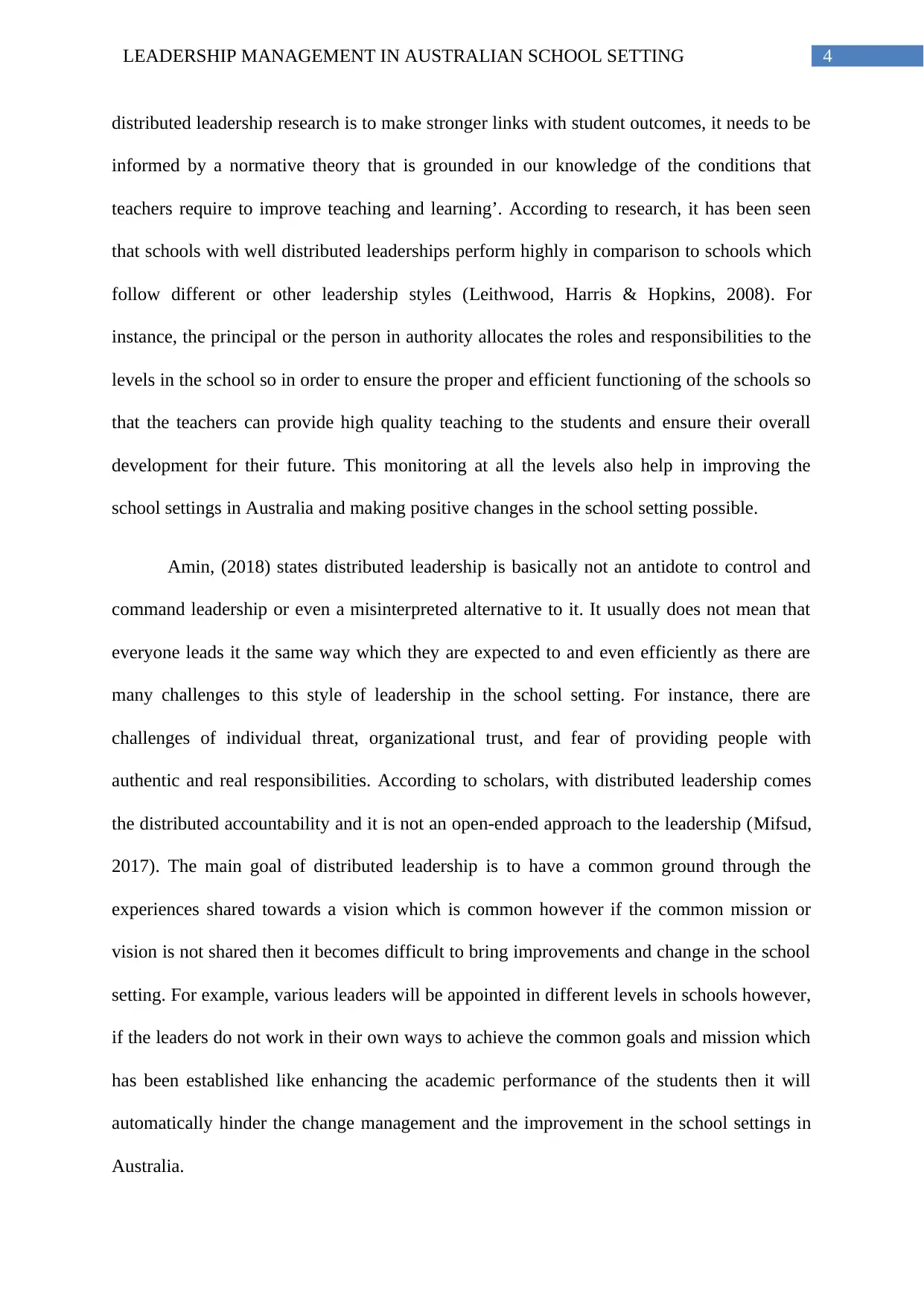
4LEADERSHIP MANAGEMENT IN AUSTRALIAN SCHOOL SETTING
distributed leadership research is to make stronger links with student outcomes, it needs to be
informed by a normative theory that is grounded in our knowledge of the conditions that
teachers require to improve teaching and learning’. According to research, it has been seen
that schools with well distributed leaderships perform highly in comparison to schools which
follow different or other leadership styles (Leithwood, Harris & Hopkins, 2008). For
instance, the principal or the person in authority allocates the roles and responsibilities to the
levels in the school so in order to ensure the proper and efficient functioning of the schools so
that the teachers can provide high quality teaching to the students and ensure their overall
development for their future. This monitoring at all the levels also help in improving the
school settings in Australia and making positive changes in the school setting possible.
Amin, (2018) states distributed leadership is basically not an antidote to control and
command leadership or even a misinterpreted alternative to it. It usually does not mean that
everyone leads it the same way which they are expected to and even efficiently as there are
many challenges to this style of leadership in the school setting. For instance, there are
challenges of individual threat, organizational trust, and fear of providing people with
authentic and real responsibilities. According to scholars, with distributed leadership comes
the distributed accountability and it is not an open-ended approach to the leadership (Mifsud,
2017). The main goal of distributed leadership is to have a common ground through the
experiences shared towards a vision which is common however if the common mission or
vision is not shared then it becomes difficult to bring improvements and change in the school
setting. For example, various leaders will be appointed in different levels in schools however,
if the leaders do not work in their own ways to achieve the common goals and mission which
has been established like enhancing the academic performance of the students then it will
automatically hinder the change management and the improvement in the school settings in
Australia.
distributed leadership research is to make stronger links with student outcomes, it needs to be
informed by a normative theory that is grounded in our knowledge of the conditions that
teachers require to improve teaching and learning’. According to research, it has been seen
that schools with well distributed leaderships perform highly in comparison to schools which
follow different or other leadership styles (Leithwood, Harris & Hopkins, 2008). For
instance, the principal or the person in authority allocates the roles and responsibilities to the
levels in the school so in order to ensure the proper and efficient functioning of the schools so
that the teachers can provide high quality teaching to the students and ensure their overall
development for their future. This monitoring at all the levels also help in improving the
school settings in Australia and making positive changes in the school setting possible.
Amin, (2018) states distributed leadership is basically not an antidote to control and
command leadership or even a misinterpreted alternative to it. It usually does not mean that
everyone leads it the same way which they are expected to and even efficiently as there are
many challenges to this style of leadership in the school setting. For instance, there are
challenges of individual threat, organizational trust, and fear of providing people with
authentic and real responsibilities. According to scholars, with distributed leadership comes
the distributed accountability and it is not an open-ended approach to the leadership (Mifsud,
2017). The main goal of distributed leadership is to have a common ground through the
experiences shared towards a vision which is common however if the common mission or
vision is not shared then it becomes difficult to bring improvements and change in the school
setting. For example, various leaders will be appointed in different levels in schools however,
if the leaders do not work in their own ways to achieve the common goals and mission which
has been established like enhancing the academic performance of the students then it will
automatically hinder the change management and the improvement in the school settings in
Australia.
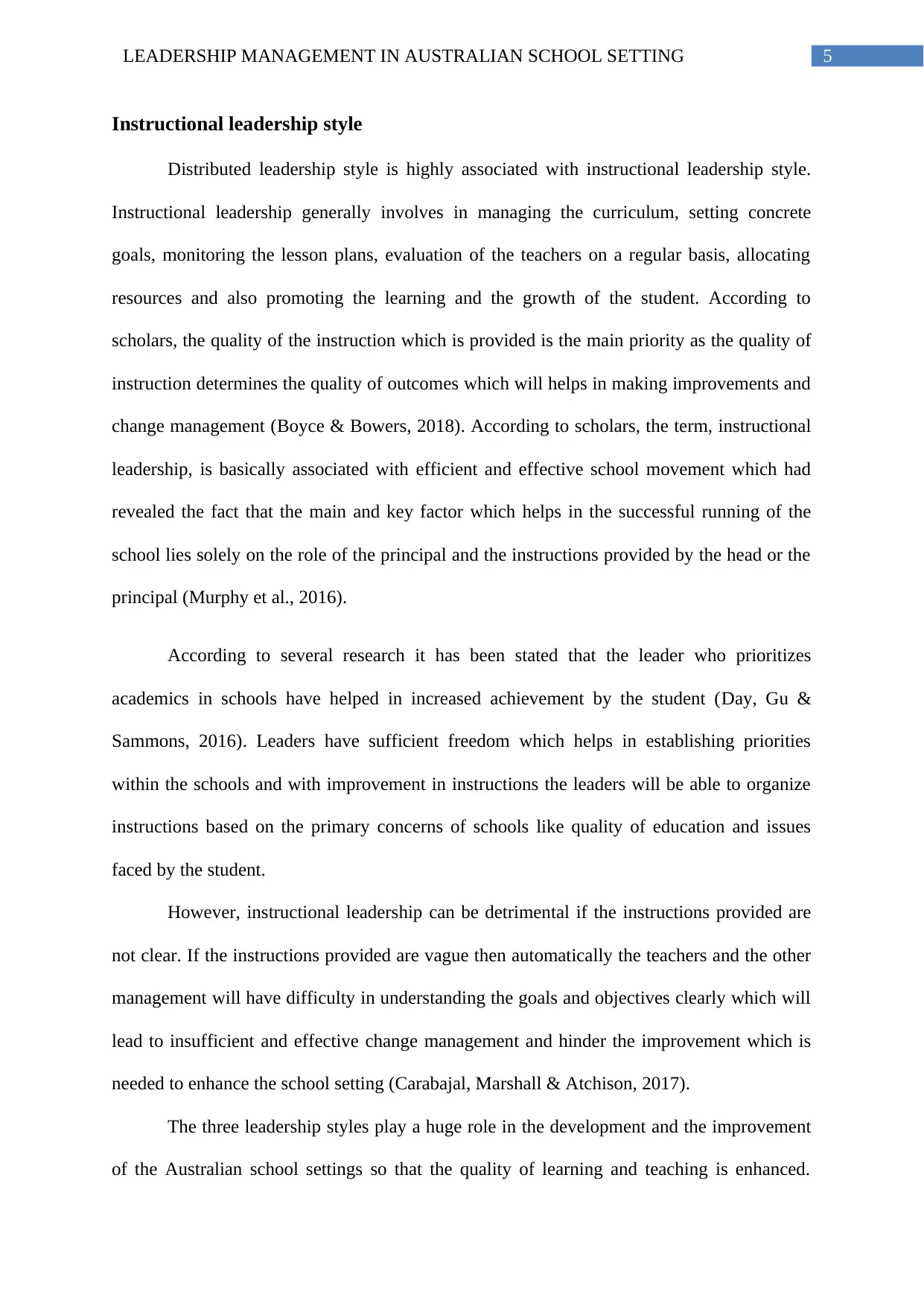
5LEADERSHIP MANAGEMENT IN AUSTRALIAN SCHOOL SETTING
Instructional leadership style
Distributed leadership style is highly associated with instructional leadership style.
Instructional leadership generally involves in managing the curriculum, setting concrete
goals, monitoring the lesson plans, evaluation of the teachers on a regular basis, allocating
resources and also promoting the learning and the growth of the student. According to
scholars, the quality of the instruction which is provided is the main priority as the quality of
instruction determines the quality of outcomes which will helps in making improvements and
change management (Boyce & Bowers, 2018). According to scholars, the term, instructional
leadership, is basically associated with efficient and effective school movement which had
revealed the fact that the main and key factor which helps in the successful running of the
school lies solely on the role of the principal and the instructions provided by the head or the
principal (Murphy et al., 2016).
According to several research it has been stated that the leader who prioritizes
academics in schools have helped in increased achievement by the student (Day, Gu &
Sammons, 2016). Leaders have sufficient freedom which helps in establishing priorities
within the schools and with improvement in instructions the leaders will be able to organize
instructions based on the primary concerns of schools like quality of education and issues
faced by the student.
However, instructional leadership can be detrimental if the instructions provided are
not clear. If the instructions provided are vague then automatically the teachers and the other
management will have difficulty in understanding the goals and objectives clearly which will
lead to insufficient and effective change management and hinder the improvement which is
needed to enhance the school setting (Carabajal, Marshall & Atchison, 2017).
The three leadership styles play a huge role in the development and the improvement
of the Australian school settings so that the quality of learning and teaching is enhanced.
Instructional leadership style
Distributed leadership style is highly associated with instructional leadership style.
Instructional leadership generally involves in managing the curriculum, setting concrete
goals, monitoring the lesson plans, evaluation of the teachers on a regular basis, allocating
resources and also promoting the learning and the growth of the student. According to
scholars, the quality of the instruction which is provided is the main priority as the quality of
instruction determines the quality of outcomes which will helps in making improvements and
change management (Boyce & Bowers, 2018). According to scholars, the term, instructional
leadership, is basically associated with efficient and effective school movement which had
revealed the fact that the main and key factor which helps in the successful running of the
school lies solely on the role of the principal and the instructions provided by the head or the
principal (Murphy et al., 2016).
According to several research it has been stated that the leader who prioritizes
academics in schools have helped in increased achievement by the student (Day, Gu &
Sammons, 2016). Leaders have sufficient freedom which helps in establishing priorities
within the schools and with improvement in instructions the leaders will be able to organize
instructions based on the primary concerns of schools like quality of education and issues
faced by the student.
However, instructional leadership can be detrimental if the instructions provided are
not clear. If the instructions provided are vague then automatically the teachers and the other
management will have difficulty in understanding the goals and objectives clearly which will
lead to insufficient and effective change management and hinder the improvement which is
needed to enhance the school setting (Carabajal, Marshall & Atchison, 2017).
The three leadership styles play a huge role in the development and the improvement
of the Australian school settings so that the quality of learning and teaching is enhanced.
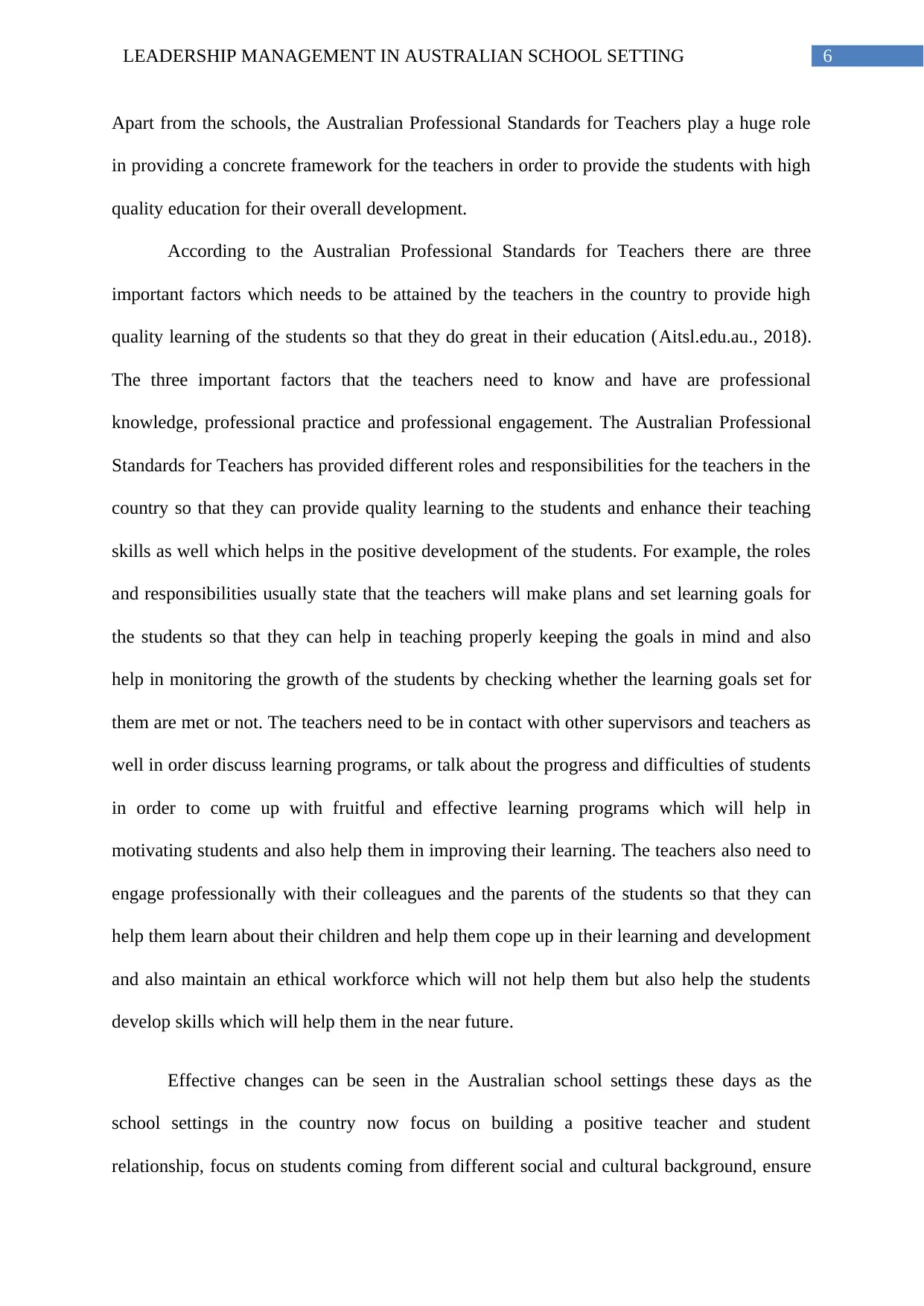
6LEADERSHIP MANAGEMENT IN AUSTRALIAN SCHOOL SETTING
Apart from the schools, the Australian Professional Standards for Teachers play a huge role
in providing a concrete framework for the teachers in order to provide the students with high
quality education for their overall development.
According to the Australian Professional Standards for Teachers there are three
important factors which needs to be attained by the teachers in the country to provide high
quality learning of the students so that they do great in their education (Aitsl.edu.au., 2018).
The three important factors that the teachers need to know and have are professional
knowledge, professional practice and professional engagement. The Australian Professional
Standards for Teachers has provided different roles and responsibilities for the teachers in the
country so that they can provide quality learning to the students and enhance their teaching
skills as well which helps in the positive development of the students. For example, the roles
and responsibilities usually state that the teachers will make plans and set learning goals for
the students so that they can help in teaching properly keeping the goals in mind and also
help in monitoring the growth of the students by checking whether the learning goals set for
them are met or not. The teachers need to be in contact with other supervisors and teachers as
well in order discuss learning programs, or talk about the progress and difficulties of students
in order to come up with fruitful and effective learning programs which will help in
motivating students and also help them in improving their learning. The teachers also need to
engage professionally with their colleagues and the parents of the students so that they can
help them learn about their children and help them cope up in their learning and development
and also maintain an ethical workforce which will not help them but also help the students
develop skills which will help them in the near future.
Effective changes can be seen in the Australian school settings these days as the
school settings in the country now focus on building a positive teacher and student
relationship, focus on students coming from different social and cultural background, ensure
Apart from the schools, the Australian Professional Standards for Teachers play a huge role
in providing a concrete framework for the teachers in order to provide the students with high
quality education for their overall development.
According to the Australian Professional Standards for Teachers there are three
important factors which needs to be attained by the teachers in the country to provide high
quality learning of the students so that they do great in their education (Aitsl.edu.au., 2018).
The three important factors that the teachers need to know and have are professional
knowledge, professional practice and professional engagement. The Australian Professional
Standards for Teachers has provided different roles and responsibilities for the teachers in the
country so that they can provide quality learning to the students and enhance their teaching
skills as well which helps in the positive development of the students. For example, the roles
and responsibilities usually state that the teachers will make plans and set learning goals for
the students so that they can help in teaching properly keeping the goals in mind and also
help in monitoring the growth of the students by checking whether the learning goals set for
them are met or not. The teachers need to be in contact with other supervisors and teachers as
well in order discuss learning programs, or talk about the progress and difficulties of students
in order to come up with fruitful and effective learning programs which will help in
motivating students and also help them in improving their learning. The teachers also need to
engage professionally with their colleagues and the parents of the students so that they can
help them learn about their children and help them cope up in their learning and development
and also maintain an ethical workforce which will not help them but also help the students
develop skills which will help them in the near future.
Effective changes can be seen in the Australian school settings these days as the
school settings in the country now focus on building a positive teacher and student
relationship, focus on students coming from different social and cultural background, ensure
Paraphrase This Document
Need a fresh take? Get an instant paraphrase of this document with our AI Paraphraser
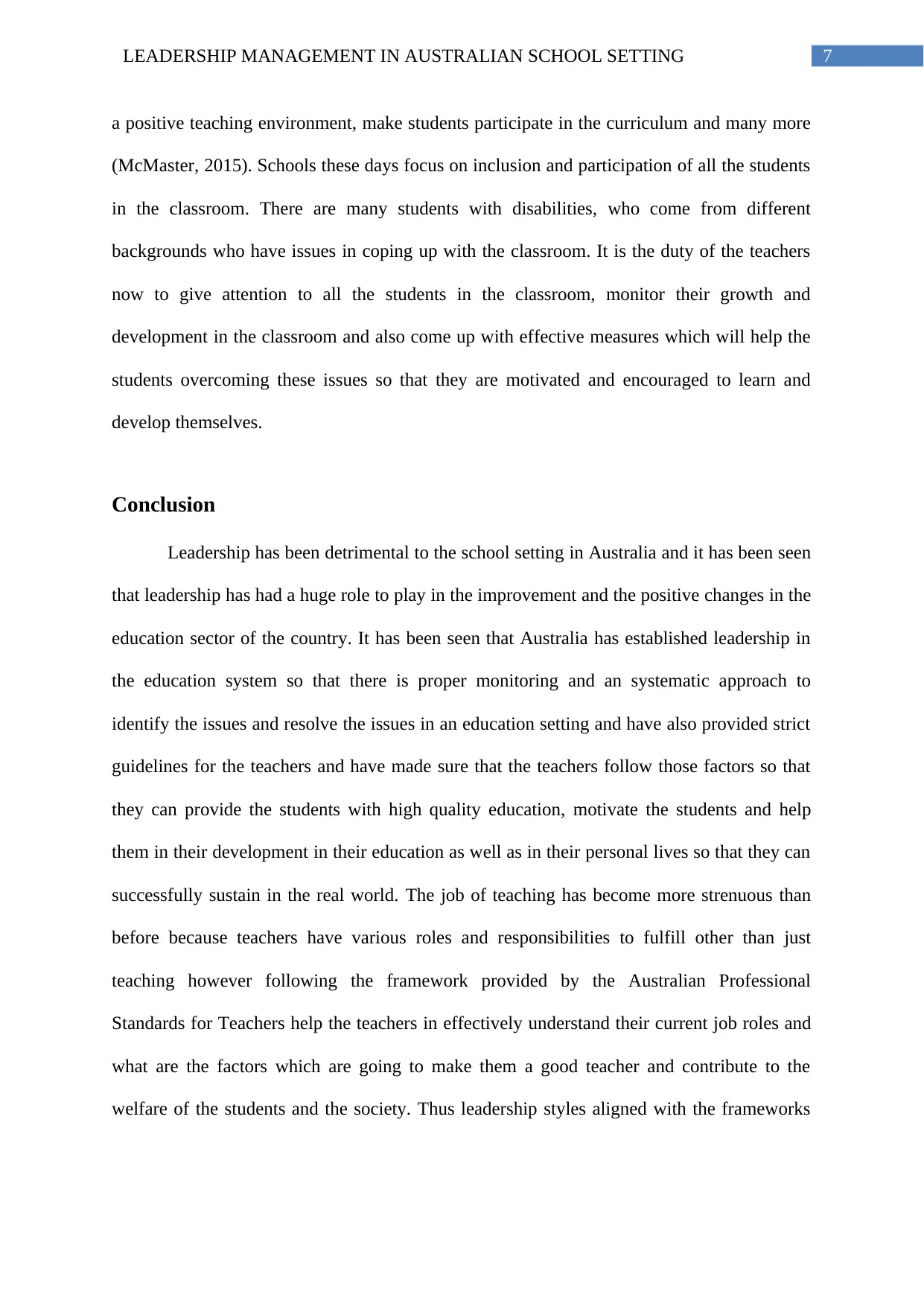
7LEADERSHIP MANAGEMENT IN AUSTRALIAN SCHOOL SETTING
a positive teaching environment, make students participate in the curriculum and many more
(McMaster, 2015). Schools these days focus on inclusion and participation of all the students
in the classroom. There are many students with disabilities, who come from different
backgrounds who have issues in coping up with the classroom. It is the duty of the teachers
now to give attention to all the students in the classroom, monitor their growth and
development in the classroom and also come up with effective measures which will help the
students overcoming these issues so that they are motivated and encouraged to learn and
develop themselves.
Conclusion
Leadership has been detrimental to the school setting in Australia and it has been seen
that leadership has had a huge role to play in the improvement and the positive changes in the
education sector of the country. It has been seen that Australia has established leadership in
the education system so that there is proper monitoring and an systematic approach to
identify the issues and resolve the issues in an education setting and have also provided strict
guidelines for the teachers and have made sure that the teachers follow those factors so that
they can provide the students with high quality education, motivate the students and help
them in their development in their education as well as in their personal lives so that they can
successfully sustain in the real world. The job of teaching has become more strenuous than
before because teachers have various roles and responsibilities to fulfill other than just
teaching however following the framework provided by the Australian Professional
Standards for Teachers help the teachers in effectively understand their current job roles and
what are the factors which are going to make them a good teacher and contribute to the
welfare of the students and the society. Thus leadership styles aligned with the frameworks
a positive teaching environment, make students participate in the curriculum and many more
(McMaster, 2015). Schools these days focus on inclusion and participation of all the students
in the classroom. There are many students with disabilities, who come from different
backgrounds who have issues in coping up with the classroom. It is the duty of the teachers
now to give attention to all the students in the classroom, monitor their growth and
development in the classroom and also come up with effective measures which will help the
students overcoming these issues so that they are motivated and encouraged to learn and
develop themselves.
Conclusion
Leadership has been detrimental to the school setting in Australia and it has been seen
that leadership has had a huge role to play in the improvement and the positive changes in the
education sector of the country. It has been seen that Australia has established leadership in
the education system so that there is proper monitoring and an systematic approach to
identify the issues and resolve the issues in an education setting and have also provided strict
guidelines for the teachers and have made sure that the teachers follow those factors so that
they can provide the students with high quality education, motivate the students and help
them in their development in their education as well as in their personal lives so that they can
successfully sustain in the real world. The job of teaching has become more strenuous than
before because teachers have various roles and responsibilities to fulfill other than just
teaching however following the framework provided by the Australian Professional
Standards for Teachers help the teachers in effectively understand their current job roles and
what are the factors which are going to make them a good teacher and contribute to the
welfare of the students and the society. Thus leadership styles aligned with the frameworks
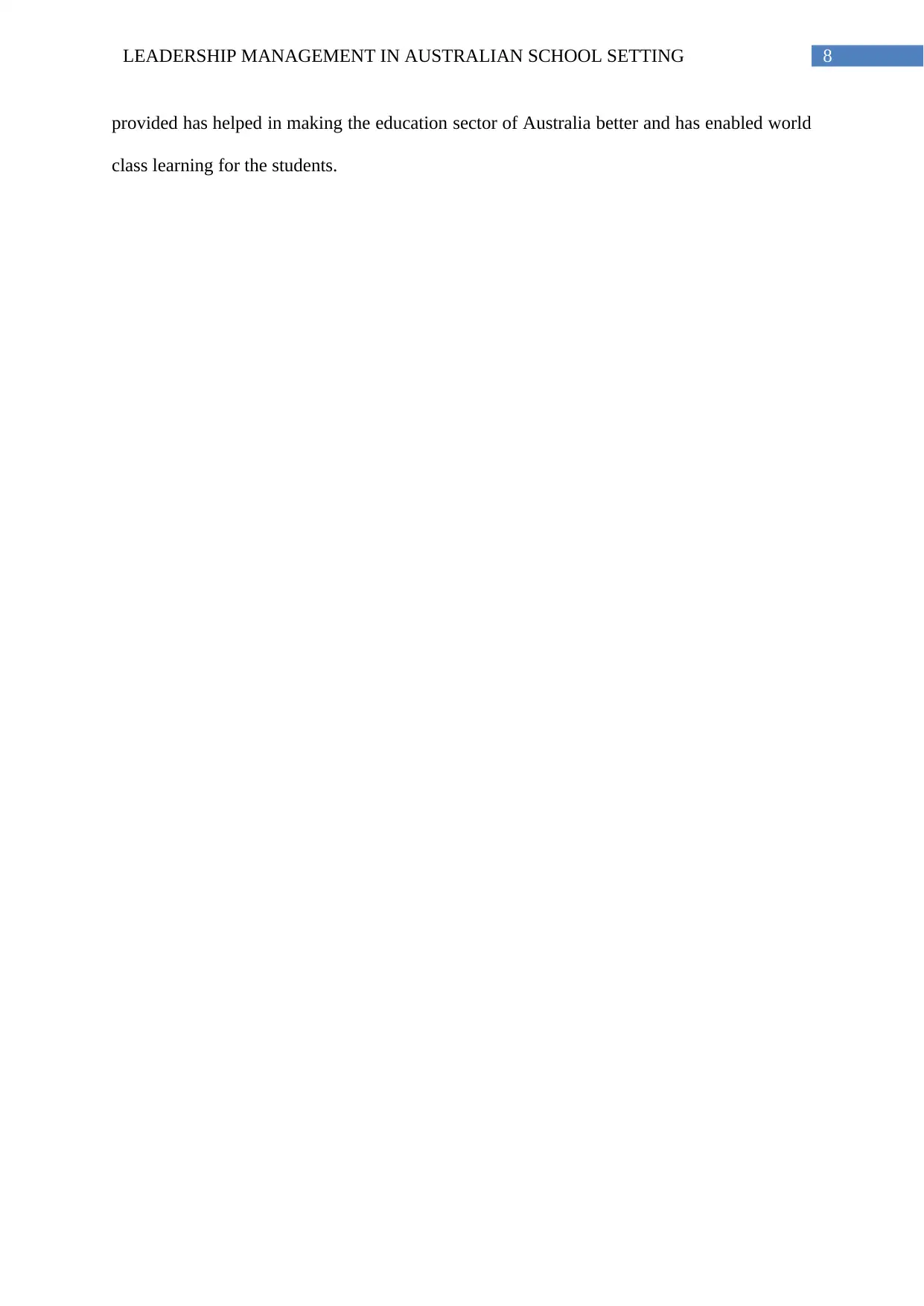
8LEADERSHIP MANAGEMENT IN AUSTRALIAN SCHOOL SETTING
provided has helped in making the education sector of Australia better and has enabled world
class learning for the students.
provided has helped in making the education sector of Australia better and has enabled world
class learning for the students.
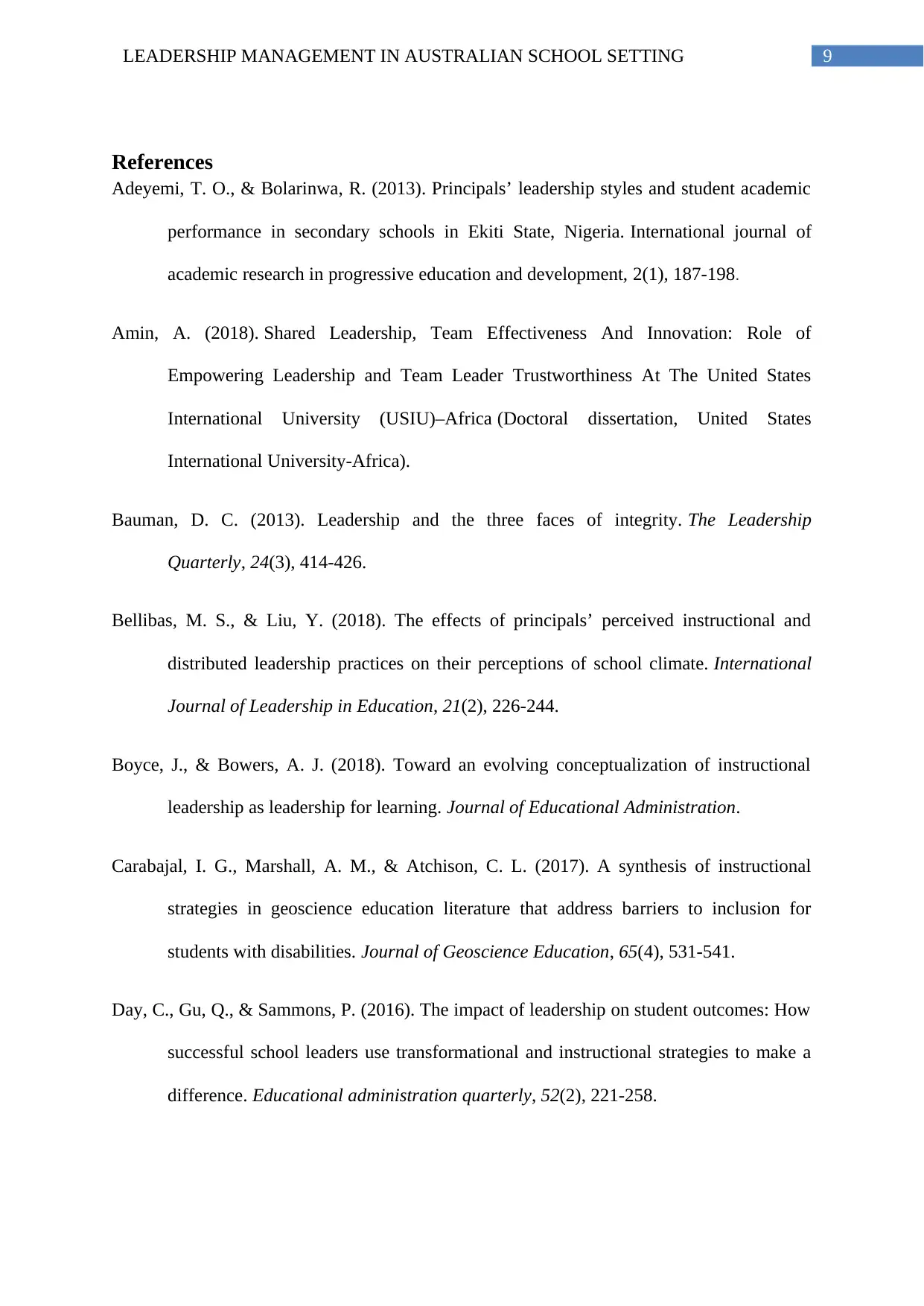
9LEADERSHIP MANAGEMENT IN AUSTRALIAN SCHOOL SETTING
References
Adeyemi, T. O., & Bolarinwa, R. (2013). Principals’ leadership styles and student academic
performance in secondary schools in Ekiti State, Nigeria. International journal of
academic research in progressive education and development, 2(1), 187-198.
Amin, A. (2018). Shared Leadership, Team Effectiveness Аnd Innovation: Role of
Empowering Leadership and Team Leader Trustworthiness At The United States
International University (USIU)–Africa (Doctoral dissertation, United States
International University-Africa).
Bauman, D. C. (2013). Leadership and the three faces of integrity. The Leadership
Quarterly, 24(3), 414-426.
Bellibas, M. S., & Liu, Y. (2018). The effects of principals’ perceived instructional and
distributed leadership practices on their perceptions of school climate. International
Journal of Leadership in Education, 21(2), 226-244.
Boyce, J., & Bowers, A. J. (2018). Toward an evolving conceptualization of instructional
leadership as leadership for learning. Journal of Educational Administration.
Carabajal, I. G., Marshall, A. M., & Atchison, C. L. (2017). A synthesis of instructional
strategies in geoscience education literature that address barriers to inclusion for
students with disabilities. Journal of Geoscience Education, 65(4), 531-541.
Day, C., Gu, Q., & Sammons, P. (2016). The impact of leadership on student outcomes: How
successful school leaders use transformational and instructional strategies to make a
difference. Educational administration quarterly, 52(2), 221-258.
References
Adeyemi, T. O., & Bolarinwa, R. (2013). Principals’ leadership styles and student academic
performance in secondary schools in Ekiti State, Nigeria. International journal of
academic research in progressive education and development, 2(1), 187-198.
Amin, A. (2018). Shared Leadership, Team Effectiveness Аnd Innovation: Role of
Empowering Leadership and Team Leader Trustworthiness At The United States
International University (USIU)–Africa (Doctoral dissertation, United States
International University-Africa).
Bauman, D. C. (2013). Leadership and the three faces of integrity. The Leadership
Quarterly, 24(3), 414-426.
Bellibas, M. S., & Liu, Y. (2018). The effects of principals’ perceived instructional and
distributed leadership practices on their perceptions of school climate. International
Journal of Leadership in Education, 21(2), 226-244.
Boyce, J., & Bowers, A. J. (2018). Toward an evolving conceptualization of instructional
leadership as leadership for learning. Journal of Educational Administration.
Carabajal, I. G., Marshall, A. M., & Atchison, C. L. (2017). A synthesis of instructional
strategies in geoscience education literature that address barriers to inclusion for
students with disabilities. Journal of Geoscience Education, 65(4), 531-541.
Day, C., Gu, Q., & Sammons, P. (2016). The impact of leadership on student outcomes: How
successful school leaders use transformational and instructional strategies to make a
difference. Educational administration quarterly, 52(2), 221-258.
Secure Best Marks with AI Grader
Need help grading? Try our AI Grader for instant feedback on your assignments.
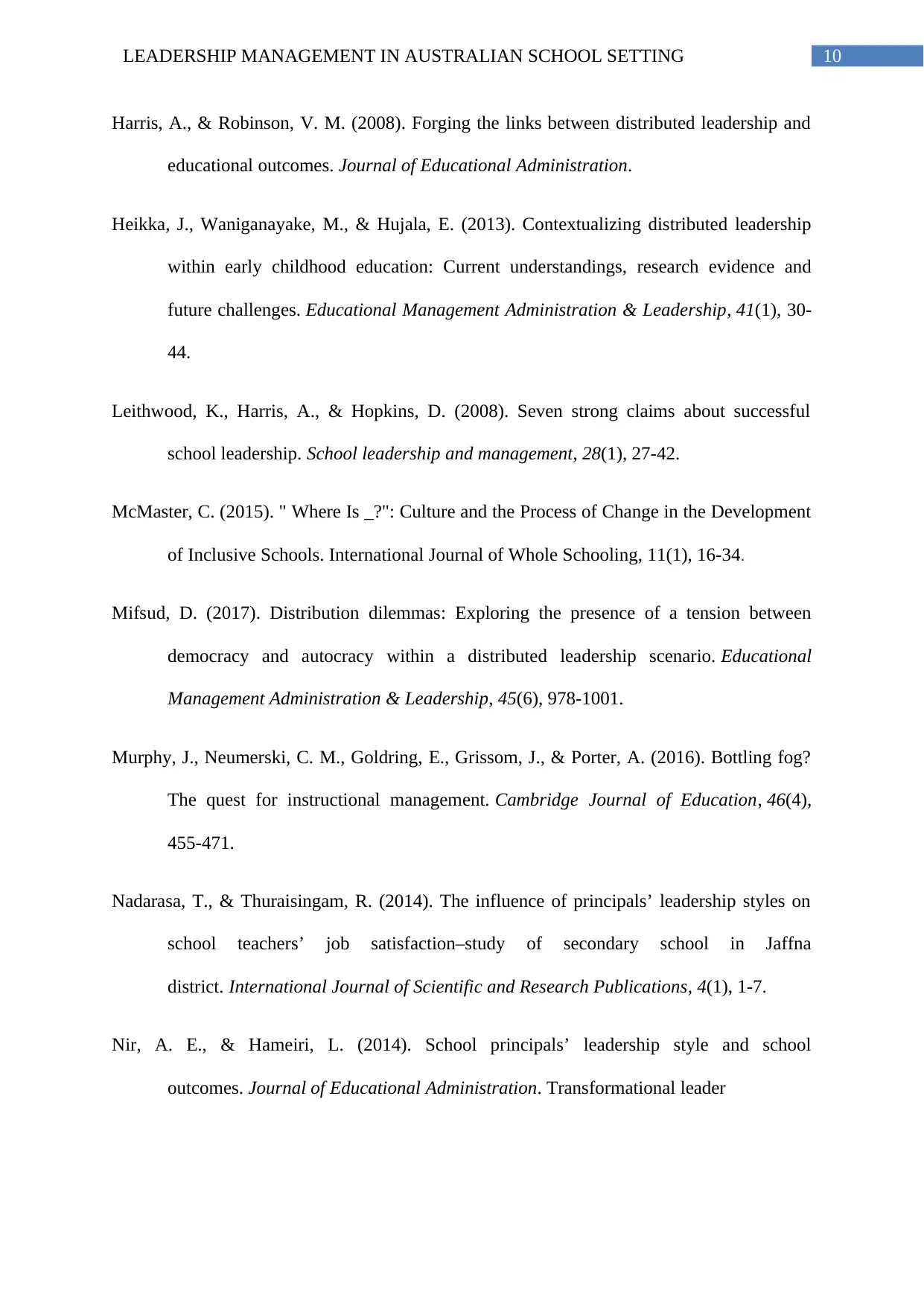
10LEADERSHIP MANAGEMENT IN AUSTRALIAN SCHOOL SETTING
Harris, A., & Robinson, V. M. (2008). Forging the links between distributed leadership and
educational outcomes. Journal of Educational Administration.
Heikka, J., Waniganayake, M., & Hujala, E. (2013). Contextualizing distributed leadership
within early childhood education: Current understandings, research evidence and
future challenges. Educational Management Administration & Leadership, 41(1), 30-
44.
Leithwood, K., Harris, A., & Hopkins, D. (2008). Seven strong claims about successful
school leadership. School leadership and management, 28(1), 27-42.
McMaster, C. (2015). " Where Is _?": Culture and the Process of Change in the Development
of Inclusive Schools. International Journal of Whole Schooling, 11(1), 16-34.
Mifsud, D. (2017). Distribution dilemmas: Exploring the presence of a tension between
democracy and autocracy within a distributed leadership scenario. Educational
Management Administration & Leadership, 45(6), 978-1001.
Murphy, J., Neumerski, C. M., Goldring, E., Grissom, J., & Porter, A. (2016). Bottling fog?
The quest for instructional management. Cambridge Journal of Education, 46(4),
455-471.
Nadarasa, T., & Thuraisingam, R. (2014). The influence of principals’ leadership styles on
school teachers’ job satisfaction–study of secondary school in Jaffna
district. International Journal of Scientific and Research Publications, 4(1), 1-7.
Nir, A. E., & Hameiri, L. (2014). School principals’ leadership style and school
outcomes. Journal of Educational Administration. Transformational leader
Harris, A., & Robinson, V. M. (2008). Forging the links between distributed leadership and
educational outcomes. Journal of Educational Administration.
Heikka, J., Waniganayake, M., & Hujala, E. (2013). Contextualizing distributed leadership
within early childhood education: Current understandings, research evidence and
future challenges. Educational Management Administration & Leadership, 41(1), 30-
44.
Leithwood, K., Harris, A., & Hopkins, D. (2008). Seven strong claims about successful
school leadership. School leadership and management, 28(1), 27-42.
McMaster, C. (2015). " Where Is _?": Culture and the Process of Change in the Development
of Inclusive Schools. International Journal of Whole Schooling, 11(1), 16-34.
Mifsud, D. (2017). Distribution dilemmas: Exploring the presence of a tension between
democracy and autocracy within a distributed leadership scenario. Educational
Management Administration & Leadership, 45(6), 978-1001.
Murphy, J., Neumerski, C. M., Goldring, E., Grissom, J., & Porter, A. (2016). Bottling fog?
The quest for instructional management. Cambridge Journal of Education, 46(4),
455-471.
Nadarasa, T., & Thuraisingam, R. (2014). The influence of principals’ leadership styles on
school teachers’ job satisfaction–study of secondary school in Jaffna
district. International Journal of Scientific and Research Publications, 4(1), 1-7.
Nir, A. E., & Hameiri, L. (2014). School principals’ leadership style and school
outcomes. Journal of Educational Administration. Transformational leader
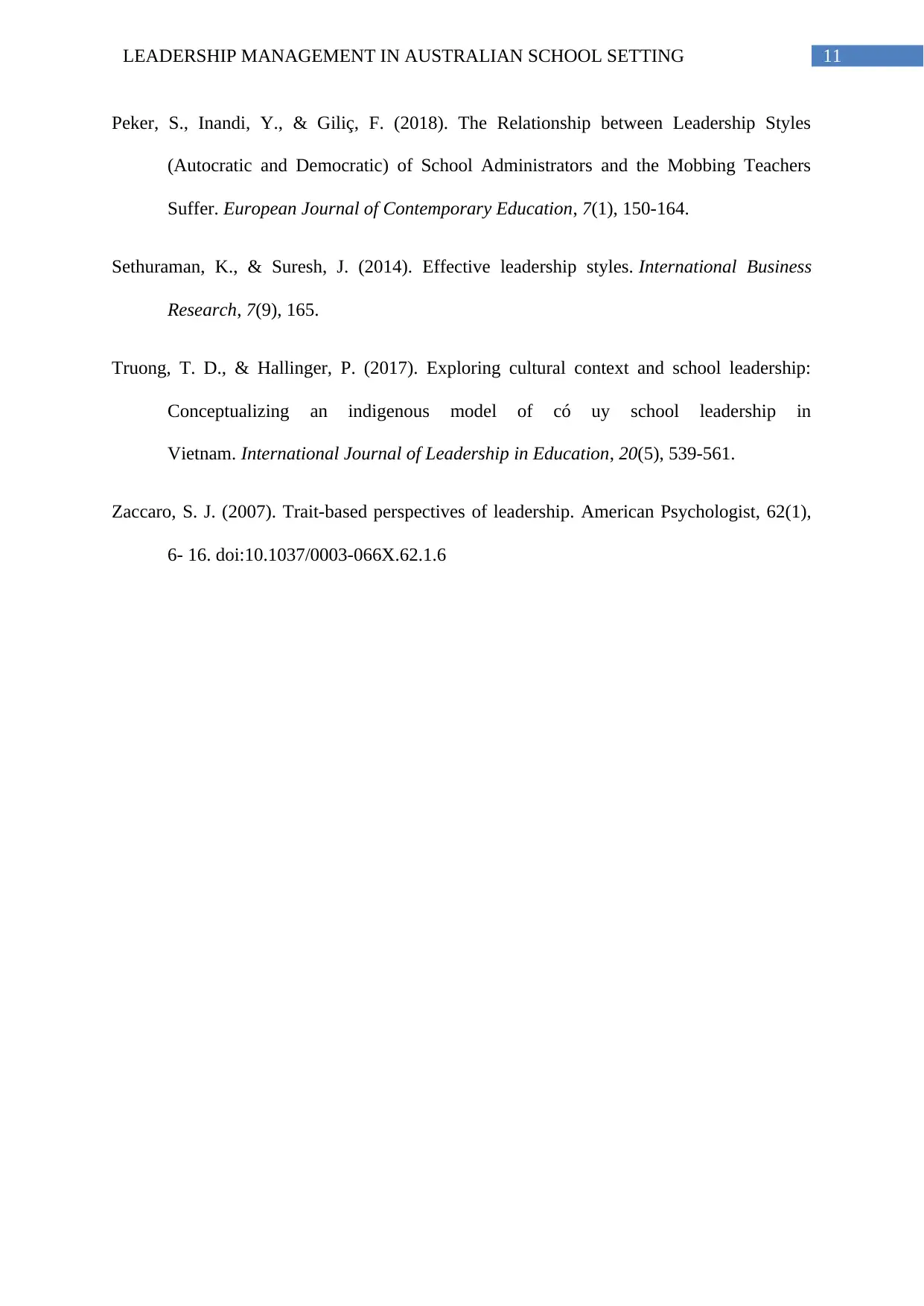
11LEADERSHIP MANAGEMENT IN AUSTRALIAN SCHOOL SETTING
Peker, S., Inandi, Y., & Giliç, F. (2018). The Relationship between Leadership Styles
(Autocratic and Democratic) of School Administrators and the Mobbing Teachers
Suffer. European Journal of Contemporary Education, 7(1), 150-164.
Sethuraman, K., & Suresh, J. (2014). Effective leadership styles. International Business
Research, 7(9), 165.
Truong, T. D., & Hallinger, P. (2017). Exploring cultural context and school leadership:
Conceptualizing an indigenous model of có uy school leadership in
Vietnam. International Journal of Leadership in Education, 20(5), 539-561.
Zaccaro, S. J. (2007). Trait-based perspectives of leadership. American Psychologist, 62(1),
6- 16. doi:10.1037/0003-066X.62.1.6
Peker, S., Inandi, Y., & Giliç, F. (2018). The Relationship between Leadership Styles
(Autocratic and Democratic) of School Administrators and the Mobbing Teachers
Suffer. European Journal of Contemporary Education, 7(1), 150-164.
Sethuraman, K., & Suresh, J. (2014). Effective leadership styles. International Business
Research, 7(9), 165.
Truong, T. D., & Hallinger, P. (2017). Exploring cultural context and school leadership:
Conceptualizing an indigenous model of có uy school leadership in
Vietnam. International Journal of Leadership in Education, 20(5), 539-561.
Zaccaro, S. J. (2007). Trait-based perspectives of leadership. American Psychologist, 62(1),
6- 16. doi:10.1037/0003-066X.62.1.6
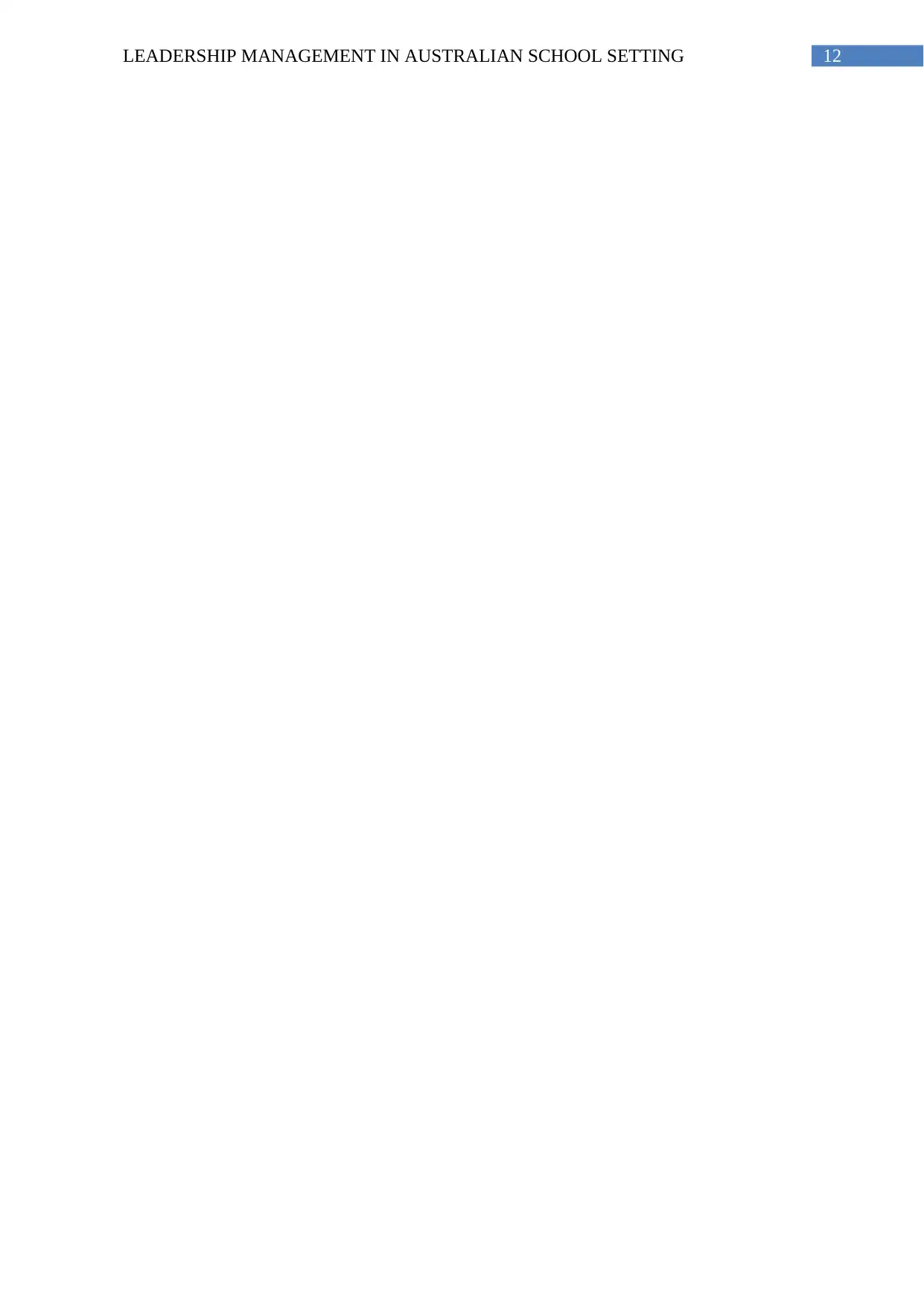
12LEADERSHIP MANAGEMENT IN AUSTRALIAN SCHOOL SETTING
1 out of 13
Related Documents
Your All-in-One AI-Powered Toolkit for Academic Success.
+13062052269
info@desklib.com
Available 24*7 on WhatsApp / Email
![[object Object]](/_next/static/media/star-bottom.7253800d.svg)
Unlock your academic potential
© 2024 | Zucol Services PVT LTD | All rights reserved.





